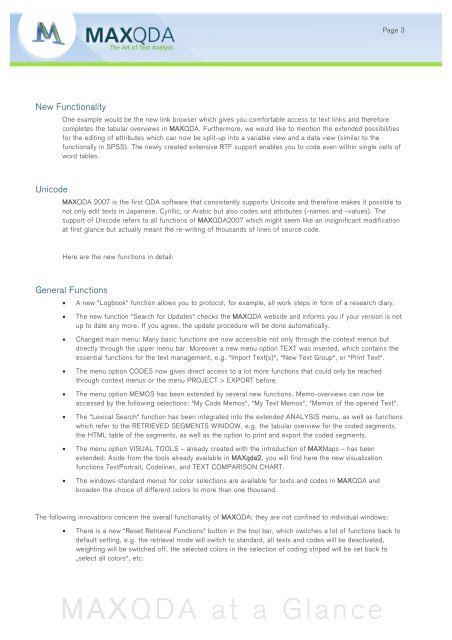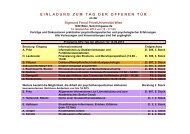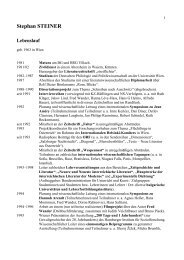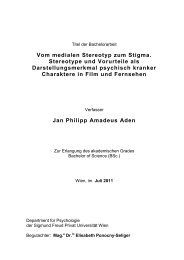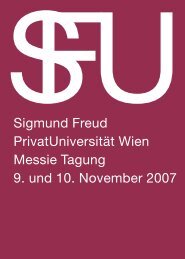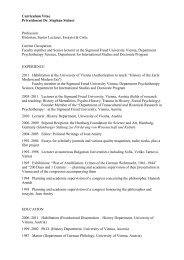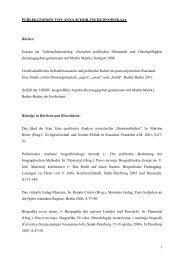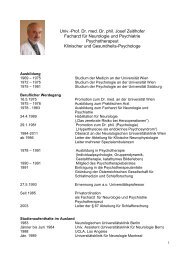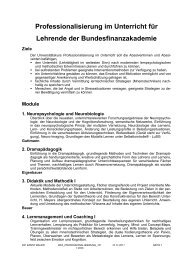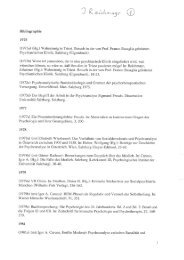Benutzer eingeben, Neue Projektdatei, Texte/Daten importieren
Benutzer eingeben, Neue Projektdatei, Texte/Daten importieren
Benutzer eingeben, Neue Projektdatei, Texte/Daten importieren
You also want an ePaper? Increase the reach of your titles
YUMPU automatically turns print PDFs into web optimized ePapers that Google loves.
New Functionality<br />
Unicode<br />
MAXQDA at a Glance<br />
Page 3<br />
One example would be the new link browser which gives you comfortable access to text links and therefore<br />
completes the tabular overviews in MAXQDA. Furthermore, we would like to mention the extended possibilities<br />
for the editing of attributes which can now be split-up into a variable view and a data view (similar to the<br />
functionally in SPSS). The newly created extensive RTF support enables you to code even within single cells of<br />
word tables.<br />
MAXQDA 2007 is the first QDA software that consistently supports Unicode and therefore makes it possible to<br />
not only edit texts in Japanese, Cyrillic, or Arabic but also codes and attributes (-names and –values). The<br />
support of Unicode refers to all functions of MAXQDA2007 which might seem like an insignificant modification<br />
at first glance but actually meant the re-writing of thousands of lines of source code.<br />
Here are the new functions in detail:<br />
General Functions<br />
• A new “Logbook“ function allows you to protocol, for example, all work steps in form of a research diary.<br />
• The new function “Search for Updates“ checks the MAXQDA website and informs you if your version is not<br />
up to date any more. If you agree, the update procedure will be done automatically.<br />
• Changed main menu: Many basic functions are now accessible not only through the context menus but<br />
directly through the upper menu bar. Moreover a new menu option TEXT was inserted, which contains the<br />
essential functions for the text management, e.g. “Import Text(s)“, “New Text Group“, or “Print Text“.<br />
• The menu option CODES now gives direct access to a lot more functions that could only be reached<br />
through context menus or the menu PROJECT > EXPORT before.<br />
• The menu option MEMOS has been extended by several new functions. Memo-overviews can now be<br />
accessed by the following selections: “My Code Memos“, “My Text Memos“, “Memos of the opened Text“.<br />
• The “Lexical Search“ function has been integrated into the extended ANALYSIS menu, as well as functions<br />
which refer to the RETRIEVED SEGMENTS WINDOW, e.g. the tabular overview for the coded segments,<br />
the HTML table of the segments, as well as the option to print and export the coded segments.<br />
• The menu option VISUAL TOOLS – already created with the introduction of MAXMaps – has been<br />
extended: Aside from the tools already available in MAXqda2, you will find here the new visualization<br />
functions TextPortrait, Codeliner, and TEXT COMPARISON CHART.<br />
• The windows-standard menus for color selections are available for texts and codes in MAXQDA and<br />
broaden the choice of different colors to more than one thousand.<br />
The following innovations concern the overall functionality of MAXQDA; they are not confined to individual windows:<br />
• There is a new “Reset Retrieval Functions“ button in the tool bar, which switches a lot of functions back to<br />
default setting, e.g. the retrieval mode will switch to standard, all texts and codes will be deactivated,<br />
weighting will be switched off, the selected colors in the selection of coding striped will be set back to<br />
„select all colors“, etc.


